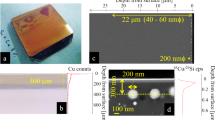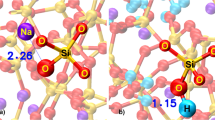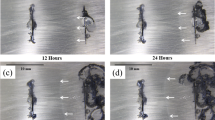Abstract
The mechanical strength of many glasses and ceramic materials decreases with time under static loading and ambient environments. This strength loss is associated with slow growth of pre-existing surface flaws due to a stress-corrosion process. To make long-term strength predictions for ceramic components, it is important to understand the stress-corrosion mechanism. We have studied stress corrosion in vitreous silica exposed to water and several non-aqueous environments and report here that environments which enhance stress corrosion are composed of molecular groups with electron donor sites on one end and proton donor sites at the other. These results suggest a detailed chemical model for the interaction of the environment with mechanically strained bonds in the solid at the tip of a crack. The proposed model also has implications for the long-term strength behaviour of a wide variety of brittle materials.
This is a preview of subscription content, access via your institution
Access options
Subscribe to this journal
Receive 51 print issues and online access
$199.00 per year
only $3.90 per issue
Buy this article
- Purchase on Springer Link
- Instant access to full article PDF
Prices may be subject to local taxes which are calculated during checkout
Similar content being viewed by others
References
Orowan, E. Nature 154, 341 (1944).
Hillig, W. B. & Charles, R. J. in High Strength Materials (ed. Zackay, V. F.) 682 (Wiley, New York, 1965).
Wiederhorn, S. M., Fuller, E. R. Jr & Thomson, R. Metal Sci. 14, 450 (1980).
Wiederhorn, S. M. & Bolz, C. H. J. Am. ceram. Soc. 53, 543 (1970).
Freiman, S. W., Mulville, D. R. & Mast, P. W. J. mater. Sci. 8, 1527–1533 (1973).
Wiederhorn, S. M. in Fracture Mechanics of Ceramics Vol. 4 (eds Bradt, R. C., Hasselman, D. P. H. & Lange, F. F.) 549 (Plenum, New York, 1978).
Budd, S. M. Phys. chem. Glass 2, 111 (1961).
Laidler, K. J. Theories of Chemical Reaction Rates (McGraw-Hill, New York, 1969).
Melander, L. & Saunders, W. H. Reaction Rates of Isotopic Molecules (Wiley, New York, 1980).
Author information
Authors and Affiliations
Rights and permissions
About this article
Cite this article
Michalske, T., Freiman, S. A molecular interpretation of stress corrosion in silica. Nature 295, 511–512 (1982). https://doi.org/10.1038/295511a0
Received:
Accepted:
Issue Date:
DOI: https://doi.org/10.1038/295511a0
This article is cited by
-
Cyclic Impact Damage and Water Saturation Effects on Mechanical Properties and Kaiser Effect of Red Sandstone Under Uniaxial Cyclic Loading and Unloading Compression
Rock Mechanics and Rock Engineering (2024)
-
Wet coating of calcite with silica nanoparticles in CO2 environment
Journal of Coatings Technology and Research (2024)
-
Long-chain anionic surfactants enabling stable perovskite/silicon tandems with greatly suppressed stress corrosion
Nature Communications (2023)
-
Influence of Water Content on Energy Partition and Release in Rock Failure: Implications for Water-Weakening on Rock-burst Proneness
Rock Mechanics and Rock Engineering (2023)
-
Dynamic compressive behavior of impact-damaged and water-soaked sandstone with different length-to-diameter ratios
Archives of Civil and Mechanical Engineering (2023)
Comments
By submitting a comment you agree to abide by our Terms and Community Guidelines. If you find something abusive or that does not comply with our terms or guidelines please flag it as inappropriate.



